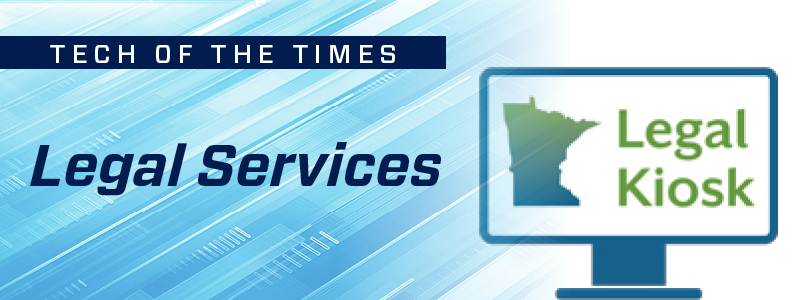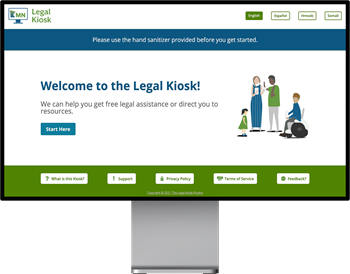
By now, we are all familiar with the myriad of ways in which the pandemic brought about shifts in nearly every aspect of our lives. And of course, the legal system was not immune to these impacts. After two and a half years, how have these changes impacted fair and just access to our legal system, and how have legal services providers adapted?
When the pandemic first hit, reliable information about the quickly-shifting legal landscape became essential. Many people turned to Google to figure out how to handle sudden job losses, unemployment, housing, and a host of other legal issues. Legal aid programs stepped in to make sure that information on Minnesota’s legal information and referral website, LawHelpMN.org, was timely and relevant. We leveraged work that had already been under way to improve search engine optimization, so that the free and accurate information on LawHelpMN showed up as high as possible in search results. Visits to the site spiked, driven by views of pages like COVID-19: Renters’ Rights During the Pandemic and COVID-19: Changes in Unemployment Benefits During the Pandemic. For example, in the week of March 22, 2020, over 16,000 people visited LawHelpMN, and nearly two-thirds of the top Google search terms people used to find LawHelpMN were related to the loss of a job.
While providing access to free, accurate and easy-to-understand online legal information was an important piece of improving access to justice, it wasn’t enough.
While providing access to free, accurate and easy-to-understand online legal information was an important piece of improving access to justice, it wasn’t enough. When the legal system shifted to a mostly virtual environment, that shift exacerbated the digital divide. It was difficult for Minnesotans without access to a stable and reliable internet connection or without access to dependable technology to meaningfully participate in the legal system. Imagine trying to attend a virtual court hearing from your phone. As a daily Zoom user, I have struggled to find the right controls when I’ve joined Zoom meetings from my phone. Now imagine using Zoom for the first time, on your phone, perhaps while juggling childcare, and while navigating a high stress legal process with which you are unfamiliar. Maybe you are attending a first appearance and don’t realize that it might be an hour before you are called. While in some ways our new virtual environment has made things easier—less time off work, less need to find transportation or childcare—in other ways, it has made realizing access to justice that much more challenging.
 Legal aid programs have stepped in to try to address this problem and level the technology playing field. In late 2020, a coalition of legal aid programs received CARES Act funding to create a statewide network of over 250 legal kiosks. These legal kiosks are located in community locations and provide free access to dependable technology and a high-quality internet connection. Many kiosks have printers and scanners, allowing people to complete applications and fill out court paperwork. Some kiosks are in public locations, while others are located in private locations that are suitable for attending a court hearing or meeting with a lawyer or advocate. Anyone can use a kiosk, and they can be used for anything from attending a court hearing or job interview, to applying for benefits or for free legal aid services. The kiosks are available in English, Spanish, Hmong, and Somali. To find a kiosk, go to www.legalkiosk.org/locations.
Legal aid programs have stepped in to try to address this problem and level the technology playing field. In late 2020, a coalition of legal aid programs received CARES Act funding to create a statewide network of over 250 legal kiosks. These legal kiosks are located in community locations and provide free access to dependable technology and a high-quality internet connection. Many kiosks have printers and scanners, allowing people to complete applications and fill out court paperwork. Some kiosks are in public locations, while others are located in private locations that are suitable for attending a court hearing or meeting with a lawyer or advocate. Anyone can use a kiosk, and they can be used for anything from attending a court hearing or job interview, to applying for benefits or for free legal aid services. The kiosks are available in English, Spanish, Hmong, and Somali. To find a kiosk, go to www.legalkiosk.org/locations.
While the shift to a more virtual world exacerbated some access to justice issues, it also opened up greater access in certain ways. Many judicial districts have worked with legal aid partners to create consolidated virtual housing calendars that make it much easier for legal aid attorneys to represent clients at hearings. For example, Legal Aid Service of Northeastern Minnesota (LASNEM), covers a mostly rural region spanning 27,000 square miles. In the pre-pandemic world of in-person only hearings, it simply was not feasible for LASNEM’s attorneys to attend every eviction hearing. In addition to the expense of long hours in the car, many tenants might not reach out to LASNEM with sufficient lead time to allow for an attorney to be present at the hearing. With the shift to virtual hearings, and in partnership with the courts, LASNEM launched an Eviction-Diversion Pilot in July 2021. Consolidated virtual calendars now allow LASNEM to attend every initial eviction hearing in its region. In the first five months of the pilot, 58% of clients who received service through the Pilot had not contacted LASNEM prior to their hearing. With the power of technology and coordination, these clients received high quality representation from LASNEM attorneys.
With virtual breakout rooms, a tenant can move from room-to-room to apply for legal services, meet with an attorney, and even apply for rental assistance.
In addition to increasing access to legal counsel, the virtual world has also allowed for greater coordination with community partners. In addition to providing access to legal counsel, LASNEM’s Eviction-Diversion Program allows tenants to meet with community partners who help with financial and housing counseling. With virtual breakout rooms, a tenant can move from room-to-room to apply for legal services, meet with an attorney, and even apply for rental assistance. Such coordination would have been much more difficult and expensive for legal aid and other nonprofit providers in an in-person world.
In addition to external work with judicial and community partners, the legal services community has also made effective use of technology to streamline their internal systems. In conjunction with a consolidated virtual housing calendar similar to the one described above, Mid-Minnesota Legal Aid (MMLA) leverages Microsoft Office 365 tools to streamline its internal processes. Microsoft apps like Forms, Power Automate, Planner, and Teams facilitate quick and efficient virtual conflict checks, application screening, data entry, and coordination. Spanish-speaking applicants are automatically assigned to Spanish-speaking staff. MMLA staff achieved this coordination by creatively using tools already at their disposal.
As with so much in life, the technological changes brought about by the pandemic have created both challenges and opportunities. While a world of virtual meetings and hearings offers great promise in creating increased access to justice, the justice community must remain vigilant that inequities are not exacerbated by this shift. With initiatives like the Legal Kiosk project, the Legal Aid community will continue to fight to make the legal system as accessible as possible.
For more information on how LASNEM has leveraged technology to assist its clients, a recent Mitchell Hamline Law Review article explores this topic: Witnessed From the Justice Bus: COVID Drove Equal Justice Off the Road, but Technology Grabbed the Wheel and Is Steering Us Into the Future.
By: J Singleton
jsingleton@mnlegalservices.org

J. Singleton is the Program Manager of Legal Services State Support. She has led many successful development and redesign projects that have improved access to justice for Minnesotans statewide, including the redesign of LawHelpMN.org, creation of Minnesota’s Legal Organizations Online Network (LOON), and development of the LawHelpMN Guide. She is a 2012 graduate of the University of Minnesota Law School and 2006 graduate of Macalester College. J. enjoys vegan baking, gardening, and taking advantage of the Minnesota outdoors, especially the Boundary Waters.